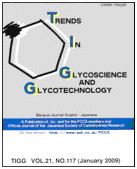All issues

Volume 23 (2011)
- Issue 134 Pages 257-
- Issue 133 Pages 201-
- Issue 132 Pages 161-
- Issue 131 Pages 111-
- Issue 130 Pages 67-
- Issue 129 Pages 1-
Volume 23, Issue 132
Displaying 1-5 of 5 articles from this issue
- |<
- <
- 1
- >
- >|
MINIREVIEW
-
Shinobu KitazumeArticle type: MINIREVIEW
2011Volume 23Issue 132 Pages 161-167
Published: 2011
Released on J-STAGE: September 29, 2011
JOURNAL FREE ACCESSDeposition of amyloid β (Aβ) in the brain is closely associated with Alzheimer’s disease (AD). Aβ is generated from β-amyloid precursor protein (APP) by the actions of β-and γ-secretases. APP and APP-cleaving enzymes (secretases) are membrane-bound glycoproteins. Several recent reports have shown that glycosylation deficiency causes abnormalities of the functional glycoprotein through protein instability, conformation changes, and impaired localization. Indeed, several reports have suggested that particular glycosylation changes would affect the functionality of APP or secretases to modulate Aβ production. In this review, I first describe the expression pattern, metabolic pathway, and posttranslational modification of APP, and then summarize recent studies, including ours, showing that particular glycosylation changes affect the formation, accumulation, and clearance of Aβ.View full abstractDownload PDF (1440K) -
Hans-Joachim GabiusArticle type: MINIREVIEW
2011Volume 23Issue 132 Pages 168-177
Published: 2011
Released on J-STAGE: September 29, 2011
JOURNAL FREE ACCESSCell surface glycans are biochemical signals for communication with the environment. They are translated into biological responses by first binding to lectins, this recognition process thereupon triggering ensuing post-binding signaling. The specificity of this interaction must necessarily be exquisite to preclude errors. Toward this end Ca2+ is recruited to the realm of protein-carbohydrate interactions. Intriguingly, not one but different strategies how Ca2+ assists in singling out the correct sugar ligands are operative. This review dissects the different ways Ca2+ functions as an integral component of various lectins’ carbohydrate-binding domains. It spans the range from the role of Ca2+ in structurally organizing the contact site without direct interaction to the ligand to interplays with charged and even neutral ligands. Finally, a case of an intricate network of up to four coordination bonds of Ca2+ with a galactose moiety is presented.View full abstractDownload PDF (1735K) -
Shou Takashima, Shuichi TsujiArticle type: MINIREVIEW
2011Volume 23Issue 132 Pages 178-193
Published: 2011
Released on J-STAGE: September 29, 2011
JOURNAL FREE ACCESSSialic acids are negatively charged acidic sugars. Sialyltransferases are enzymes that catalyze the synthesis of sialylglycoconjugates, which play important roles in various biological processes. Twenty members of the mammalian sialyltransferase superfamily have been identified to date. These enzymes are grouped into 4 families according to the type of carbohydrate linkage they synthesize: β-galactoside α2,3-sialyltransferases (ST3Gal-I-VI), β-galactoside α2,6-sialyltransferases (ST6Gal-I and -II), GalNAc α2,6-sialyltransferases (ST6GalNAc-I-VI), and α2,8-sialyltransferases (ST8Sia-I-VI). Each sialyltransferase has its specific function in the complicated mammalian body system. In this review, we describe the functional diversity of mammalian sialyltransferases on the basis of recent studies and discuss the necessity for 20 different sialyltransferases.View full abstractDownload PDF (1451K)
GLYCOTOPIC
-
Yuko Naito-MatsuiArticle type: GLYCITOPIC
2011Volume 23Issue 132 Pages 194-196
Published: 2011
Released on J-STAGE: September 29, 2011
JOURNAL FREE ACCESSDownload PDF (654K) -
Shuji MizumotoArticle type: GLYCITOPIC
2011Volume 23Issue 132 Pages 197-199
Published: 2011
Released on J-STAGE: September 29, 2011
JOURNAL FREE ACCESSDownload PDF (679K)
- |<
- <
- 1
- >
- >|